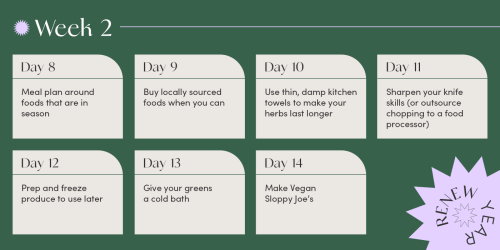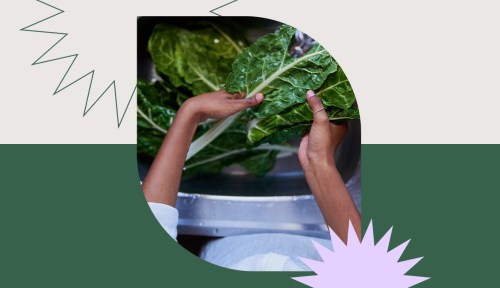Virtually everyone has experienced that ping of guilt about having to throw out expired food. Hey, it’s happened to me too. But I’ve gotten a lot better at reducing my food waste (both at my restaurant and at home). The reason why? I’ve learned a few tricks along the way about keeping food fresh for longer. And this week, I’m sharing my secrets with you, including how to bring wilted greens back from the dead.
It’s also time to head back to the grocery store again, so I’ll share a few tips to keep in mind while you’re meal planning and shopping that will cut down on waste, too. We’ll end the week by cooking one of my favorite plant-based meals: vegan sloppy joe’s. I promise it will win over even the hardcore meat lovers in hour house.

Day 8: Meal plan around foods that are in season
We learned last week that eating sustainably doesn’t start in the kitchen; it actually begins with grocery shopping. Today, we’ll do our homework to learn about buying seasonal foods, which are often sourced closer to your locale and have richer flavors and nutritional benefits because they’re being harvested under ideal conditions.
It’s important to do this research ahead of hitting the grocery store tomorrow, so you know exactly what fresh fruits, vegetables, and other seasonal foods to keep an eye out for as you shop. The basic planning principle to keep in mind is this: As you formulate your meals and recipes for the week ahead, consider incorporating more foods that are in season in your area and add them to your shopping list. Swap your summer-centric gazpacho for a warming winter squash soup, or try topping your yogurt parfait with fresh citrus slices instead of pineapple—both winter squash and citrus are at their peak right now.
If you’re not sure where to start, check out the Seasonal Food Guide to find what’s in season in your area. And keep in mind that buying seasonal food applies outside the produce section, too. For example, there are also seasonal types of fish because water temperature varies by season and spawning takes place at certain times of the year. Chef’s Resources has a great chart showing what type of fish is in season for each month of the year—and you don’t have to be a professional chef to use it.
Day 9: Buy locally sourced foods when you can
Prioritizing buying foods that are in season goes hand-in-hand with today’s tip: seeking out local foods. Buying food that’s sourced locally is a great way to make your ingredient purchases more climate-friendly. Because the fresh produce, fish, or cheese (for instance) come from your local area, they have a smaller carbon footprint, and as a bonus, buying this way also supports local farmers. Check out your local farmers’ market, if you’re fortunate enough to live in a place that has one. Many even accept EBT.
Even if there isn’t a farmers’ market near you, most grocery stores devote a section in the produce area to food that’s locally sourced. Usually, it’s right in front, highlighting new seasonal items. I know Publix, Whole Foods, Sprouts, and most Kroger stores all do this—and many other supermarkets do as well. If you don’t see a kiosk showcasing locally-grown food, don’t be afraid to ask a store employee to help you find what you’re looking for. Most are happy to help!
Later in the week, I’ll show you how to make vegan sloppy joe’s using two veggies that are in season right now, potatoes and onion. Below is the list of all the ingredients, so you can plan ahead:
- 1 small onion, chopped
- 1 clove garlic, minced
- 1 tsp ginger, grated
- 1 cup frozen cauliflower rice or fresh cauliflower florets
- 2 red skin potatoes, peeled and chopped
- 1/2 green bell pepper
- 1/2 carrot, chopped
- 1/4 cup frozen peas
- 1/4 tsp cayenne pepper
- 1 tsp turmeric
- Kosher salt, to taste
- 1/2 lemon, juiced
- 1 tsp garam masala
- 1/4 cup chopped cilantro for garnish
- Wedges of lemon
- Bread for serving
Day 10: Use thin, damp kitchen towels to make your herbs last longer
One obstacle that many home chefs face that leads to food waste? Not using herbs before they go bad. I’ll let you in on a little culinary secret: There’s an easy way to get a few days more life out of your basil, cilantro, parsley, and so on. Wash your herbs and wrap them in a thin, damp kitchen towel (you can get them for super cheap from the dollar store) or paper towel. Then, place them in a storage container or reusable baggie. The damp towel keeps the herbs hydrated so they don’t dry out as quickly. It works for those greens you just revived, too.
Day 11: Sharpen your knife skills (or outsource chopping to a food processor)
Many folks tell me that the hardest part about eating more veggies is chopping them up. I get it, slicing and dicing mountains of veggies can feel laborious—but it doesn’t have to. Practicing your knife skills is a surefire way to save tons of time when preparing plant-based meals, plus you’ll waste fewer of those precious sweet potatoes or brussels sprouts if you know the proper way to dice them up.
For starters, make sure your knife is sharp. Chopping veggies with a dull blade won’t just slow you down—because it requires more force, it’s not safe to use one. Once your knife has been sharpened, make sure you’re holding it properly. To do so, put your middle, ring, and pinky fingers around the handle, and grip the blade with your index finger and thumb. Then, to correctly chop, hold the item with one hand and then keep the tip of your knife on your board and with the other move up and down. Lastly, when prepping produce, square the bottom section of round items, like apples and potatoes. This will help anchor them properly to your cutting board, meaning chopping evenly-sized pieces will be easier—and significantly less waste will be created along the way.
Finally, for a solution that requires zero elbow grease, you can also outsource the entire chopping task to your food processor or mandoline slicer.
Day 12: Prep and freeze produce to use later
One reason why produce often dies in the fridge without being used is that it can feel like so much work to prep it for your meal. When it’s 7 p.m. after a long day, you just want to get something on the table ASAP—and that often means skipping any extra cooking steps, like chopping up veggies to incorporate into your dinner.
By this point in the week, you should have a pretty good idea of which produce you’ve purchased that you’re going to be able to finish, and which produce has the potential to be wasted. So today, take those veggies that you’re not going to utilize this week, chop them up, and stash ‘em in the freezer. That way, they’re ready to throw into a skillet, in a pot, or be easily integrated into whatever you’re cooking later on. Taking time each week to do this one thing can cut down on waste—and save you money so that you don’t have to buy veggies only to watch them wilt before your eyes.
Day 13: Give your greens a cold bath
You bought your in-season, locally grown greens. And decided to forgo freezing them so that you could eat them fresh this week, and now, you’re ready to use them. Then, you open the fridge to find them slightly wilted—despite being fresh-picked and free of any signs of spoilage. Don’t give up just yet, because there’s an easy way to revive them: Just give them a cold water bath. Trust me, it works! Greens are about 90 percent water, so hydration goes a long way in bringing them to life. Fill a large bowl with ice-cold water and submerge your greens in it. Let them hang out there for about an hour. Following this, your greens should be resurrected.
Day 14: Make Vegan Sloppy Joe’s
You’ve worked hard this week to seek out the most sustainable seasonal produce when shopping, plus you’ve tackled how to prep and preserve your fruits and veggies in ways that cut back on unnecessary waste. Kudos! Next, you’re going to need a dinner recipe that helps use up your delicious bounty of fresh (and frozen) produce, and my six-veggie vegan sloppy joe’s are just the thing. Check back on January 16, when I’ll be sharing the full ingredient list and instructions for how to make the recipe.
Looking to hit refresh on your healthy habits this January? Check out our full 2022 ReNew Year program for expert-led plans for better sleep, nutrition, exercise, and self-care routines.
Sign Up for Our Daily Newsletter
Get all the latest in wellness, trends, food, fitness, beauty, and more delivered right to your inbox.
Got it, you've been added to our email list.










